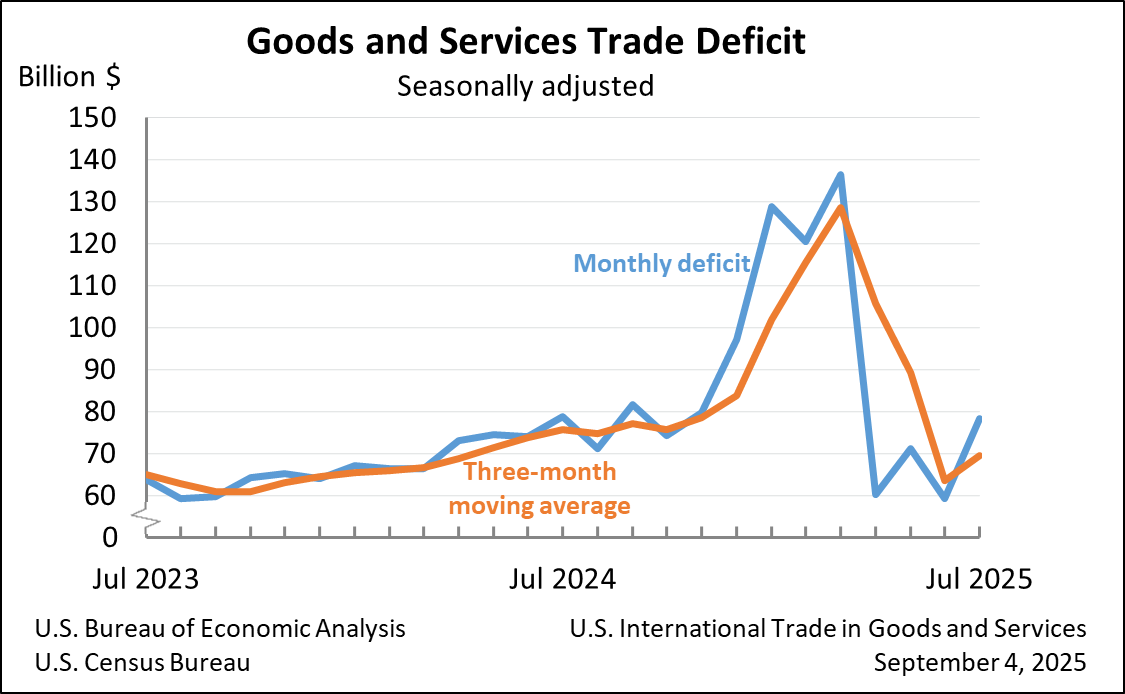Bureau of Economic Analysis
U.S. International Trade in Goods and Services, July 2025
The U.S. goods and services trade deficit increased in July 2025 according to the U.S. Bureau of Economic Analysis and the U.S. Census Bureau. The deficit increased from $59.1 billion in June (revised) to $78.3 billion in July, as imports increased more than exports. The goods deficit increased $18.2 billion in July to $103.9 billion. The services surplus decreased $1.1 billion in July to $25.6 billion.
Principal Federal Economic Indicators
Noteworthy
The Latest
What is the Value of Household Work?
The Nobel Prize winner Simon Kuznets presented an original set of estimates to Congress in 1934 that contained a number of caveats about what was omitted from the calculation of national income (and later from the calculation of gross domestic product) that made it an imperfect measure of welfare.
April Trade Gap is $50.1 Billion
The U.S. monthly international trade deficit decreased in April 2012, according to the U.S. Bureau of Economic Analysis and the U.S. Census Bureau. The deficit decreased from $52.6 billion (revised) in March to $50.1 billion in April, as imports decreased more than exports. The previously published March deficit was $51.8 billion. The goods deficit decreased $2.7 billion from March to $64.8 billion in April, and the services surplus decreased…
U.S. International Trade in Goods and Services, April 2012 U.S. International Trade in Goods and Services, 2011 annual revision
-->
Widespread State Economic Growth in 2011
Real GDP increased in 43 states and the District of Columbia in 2011. Leading industry contributors were durable-goods manufacturing; professional, scientific, and technical services; and information services.
Durable-goods manufacturing was the leading contributor to real GDP growth in 26 states, contributing 3.94 percentage points to growth in Oregon and 1.17 percentage points to growth in Michigan.
Gross Domestic Product by State, 2011 (advance estimate) and 1997-2010 (revised estimate)
EMBARGOED UNTIL RELEASE AT 8:30 A.M. EDT, TUESDAY, JUNE 5, 2012
Real Consumer Spending Picks Up in April
Personal income increased 0.2 percent in April after increasing 0.4 percent in March.
Current-dollar disposable personal income (DPI)—after-tax income—increased 0.2 percent in April after increasing 0.4 percent in March.
Real DPI—income adjusted for taxes and inflation—increased 0.2 percent in April, the same increase as in March.
Real consumer spending—spending adjusted for price changes—rose 0.3 percent in April…
Personal Income and Outlays, April 2012
Personal income increased $31.7 billion, or 0.2 percent, and disposable personal income (DPI) increased $22.0 billion, or 0.2 percent, inApril, according to the Bureau of Economic Analysis. Personal consumption expenditures (PCE) increased $31.8 billion, or 0.3 percent. In March, personal income increased $52.2 billion, or 0.4 percent, DPI increased $45.9 billion, or 0.4 percent, and PCE increased $25.4 billion, or 0.2 percent, based on…
GDP Growth Moderates in First Quarter
Real gross domestic product (GDP) rose 1.9 percent in the first quarter of 2012 after rising 3.0 percent in the fourth quarter, according to the second estimate released today by the Bureau of Economic Analysis. The first-quarter growth rate was 0.3 percentage point less than the “advance” estimate released in April.
Over the past 4 quarters, real GDP grew 2.0 percent.
First-quarter highlights An acceleration in consumer…
Gross Domestic Product, 1st quarter 2012 (second estimate); Corporate Profits, 1st quarter 2012 (preliminary estimate)
Real gross domestic product -- the output of goods and services produced by labor and property located in the United States -- increased at an annual rate of 1.9 percent in the first quarter of 2012 (that is, from the fourth quarter to the first quarter), according to the "second" estimate released by the Bureau of Economic Analysis. In the fourth quarter of 2011, real GDP increased 3.0 percent. The GDP estimate released today is based on…
What is the U.S. Bureau of Economic Analysis?
The U.S. Bureau of Economic Analysis, a unit of the U.S. Department of Commerce, is the federal agency responsible for measuring the U.S. economy, or as some say, BEA is the nation’s accountant.




